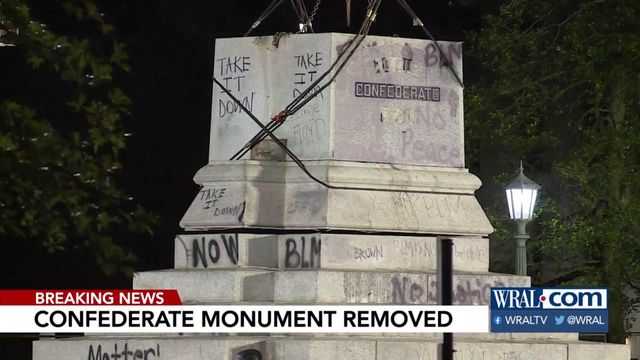Work to remove 75-foot tall Confederate monument at State Capitol postponed
Crews started work to remove a 75-foot Confederate monument on the State Capitol grounds Tuesday morning but stopped hours later due to technical difficulties.
Posted — UpdatedAccording to a worker on-site, one of the straps used to hold the statue popped while a crane tried to lift it, indicating the machine wasn't strong enough to lift the monument. Crews have ordered another crane that will arrive in separate trailers and have to be assembled on-site.
The new crane arrived Tuesday evening and workers returned to the scene to attempt to complete the removal of the monument.
On Monday night shortly after 10 p.m., crews arrived with heavy construction equipment to remove the base of the Confederate soldier monument.
Crews have been working to take down it and other monuments since Saturday after Gov. Roy Cooper, concerned about safety, ordered state workers to remove them. State Capitol police have been guarding the monument for days.
"I have ordered the Confederate monuments on the Capitol grounds be moved to protect public safety. I am concerned about the dangerous efforts to pull down and carry off large, heavy statues and the strong potential for violent clashes at the site. If the legislature had repealed their 2015 law that puts up legal roadblocks to removal we could have avoided the dangerous incidents of last night," wrote Cooper.
A worker at the site estimates "hundreds of thousands" of dollars have been spent to remove the monuments at the State Capitol.
North Carolina's Sons of Confederate Veterans group issued a statement condemning the governor’s actions, saying the monuments honor fallen Confederate soldiers. Historians say these monuments were used to control the narrative about the Civil War.
Crews came out to Capitol Square on Saturday morning to remove the two Confederate monuments – the Women of the Confederacy Monument and a statue of Henry Lawson Wyatt, the first Confederate soldier to die in the Civil War.
"Monuments to white supremacy don’t belong in places of allegiance, and it’s past time that these painful memorials be moved in a legal, safe way," wrote Cooper.
Saturday, House Speaker Tim Moore condemned Cooper's actions:
“(Friday) night, Gov. Cooper's administration ordered law enforcement to stand down while a lawless mob destroyed state property. Gov. Cooper used that failure to justify removing the statues unilaterally instead of following the process laid out in state law. Remarkably, Gov. Cooper's actions come just one day after he blocked legislation providing a lifeline to struggling families across North Carolina. Not only is Gov. Cooper is failing our small businesses, but he is failing to uphold his constitutional duty to execute the law."
Both statues were been lifted off of of their base in downtown Raleigh and crews and put the statues into flatbed trucks.
Friday night, or Juneteenth, two pieces of a Confederate monument were toppled during protests, as crowds used straps to pull them down. Both of the statues were dragged in the street and eventually tied to light fixtures and pulled up to mimic hangings.
Approval and protection for monuments and memorials
Some citizens have questioned whether or not Cooper had the authority to remove the Confederate monuments.
According to a law passed in 2015, approval from the North Carolina Historical Commission is required before a monument, memorial or work of art owned by the state can be removed, relocated or altered.
However, the law also says a monument can be removed "when appropriate measures are required by the State or a political subdivision of the State to preserve the object" or a monument that "has determined to pose a threat to public safety because of an unsafe or dangerous condition."
Historic background on the removed Confederate monuments
This 75-foot-tall statue was unveiled in 1895, around 30 years after the end of the Civil War.
It has an interesting history of controversy, even dating back to its installment.
At the time of its unveiling, "Populist and Republican leaders objected to any public funding of the monument on the grounds that public education, rather than sectional pride, was a pressing need."
Another outcry occurred in the 1930s in response to the possibility of moving the monument off the Capitol Grounds and onto Nash Square. Raleigh's citizens spoke out against "moving such a historically significant monument from such a highly visible location."
When the monument was unveiled, Julia Jackson Christian, Granddaughter of famous Confederate General Thomas "Stonewall" Jackson, spoke at the event.
Dedicated in 1912, this statue commemorates Henry Lawson Wyatt, the first Confederate soldier killed in fighting during the Civil War at the Battle of Bethel on June 10, 1861.
Dedicated in 1914, the monument to the North Carolina Women of the Confederacy commemorated the wives and daughters left behind in the South while men went off to fight the war.
It was originally was planned to depict a woman holding her daughter, but was changed to a woman holding her son, who has a sword. The statue meant to show that, although a woman couldn't vote, she could serve her country by raising good citizens.
Related Topics
• Credits
Copyright 2024 by Capitol Broadcasting Company. All rights reserved. This material may not be published, broadcast, rewritten or redistributed.






